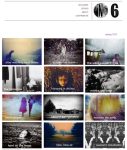The Briar Cliff Review – 2012
As always, The Briar Cliff Review makes a strong impression from the second it is placed in your hands. The journal’s large pages offer poetry, fiction, and nonfiction room to breathe and allow pieces of graphic art to be reproduced in flattering detail. In her introductory note, Editor Tricia Currans-Sheehan affirms her obvious desire to embrace the “print-ness” of the review. The magazine, she says, “is for holding and looking and for leafing through—with a treat for the eye and mind on each page.” Continue reading “The Briar Cliff Review – 2012”

